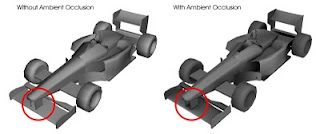 One problem of AO is that it is expansive to calculate. We cannot afford to calculate AO at run-time. So people pre-calculate AO values and they are used at run-time. In this way, AO values are valid only for static objects, because if objects move AO values must be re-calculated and we cannot afford it.
One problem of AO is that it is expansive to calculate. We cannot afford to calculate AO at run-time. So people pre-calculate AO values and they are used at run-time. In this way, AO values are valid only for static objects, because if objects move AO values must be re-calculated and we cannot afford it.One novel approach was known as SSAO. AO calculation is done in screen-space with depth buffer; optionally with normal buffer.
SSAO does not give as good looking as pre-calculated AO values although it is still better than not using at all. In addition, one thing we need to notice is that SSAO is still not cheap at run-time.
 For the screen-shot above, you can see a sofa on right side which has two cushions. And you can see a table. The screen-shot shows AO between the sofa and table which is represented by darker color. But actually the distance between table and sofa is relatively far, although it appears to be closer on the screen space. So the SSAO result is not quite correct. I feel it is more like dark glow effect from sofa or some kind of wrong shadow.
For the screen-shot above, you can see a sofa on right side which has two cushions. And you can see a table. The screen-shot shows AO between the sofa and table which is represented by darker color. But actually the distance between table and sofa is relatively far, although it appears to be closer on the screen space. So the SSAO result is not quite correct. I feel it is more like dark glow effect from sofa or some kind of wrong shadow.My idea is a kind of hybrid way between SSAO and pre-calculated AO. When a object is moving, we use SSAO, and when the object stop moving, we use a better AO value that is calculated at run-time. Although AO calculation is expensive then SSAO, once the AO values are calculated, it does not need to be recalculated until the object moves again.
First, we can detect whether or not a object is stabilized from physic engine API. Once stabilizing objects or sleeping objects were a big issue on physic implementations. People have improved it year by year. Since physic engines are handling this big issue, we can easily find which objects are about to be static.
Second, we can use SSAO until the better AO values are calculated. It is ok to spend more time than two or several frames as long as SSAO plays its role. Once the AO calculation is done, we replace SSAO with the better AO values. Then we will get a better look and don't need to do the expensive SSAO for the static objects.
 This is just an idea. I haven't tested it yet.
This is just an idea. I haven't tested it yet.One thing I'm afraid of is that when we replace SSAO with the better AO, player may notice the changes. It may give wrong information that something was moving there. So it should be gradually changing. Another thing is that I don't know how much expensive the better AO calculation will be. It may not feasible at run-time at all. Lastly, I am not quite sure how to differentiate SSAO rendering and AO rendering in a scene. Since SSAO will use just a big screen-quad, we may or may not be able to selectively calculate SSAO with a stencil buffer.
I wish I can have a chance to implement this idea sooner or later.

No comments:
Post a Comment